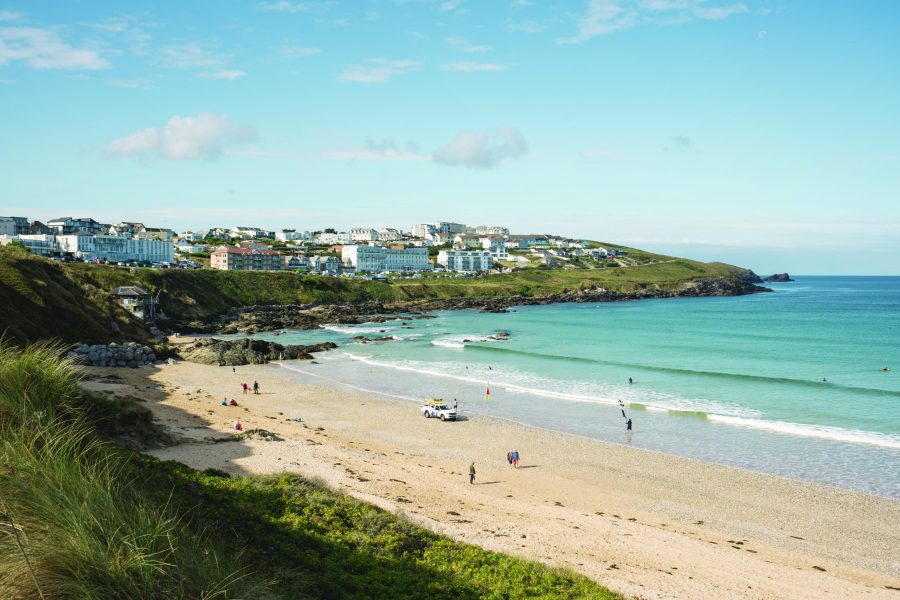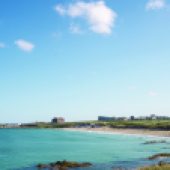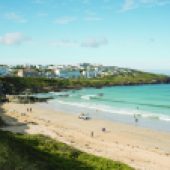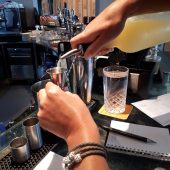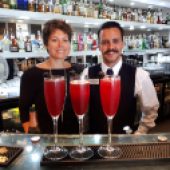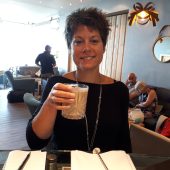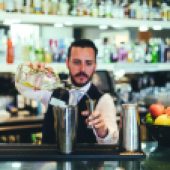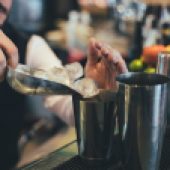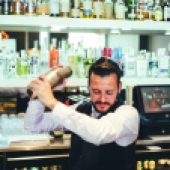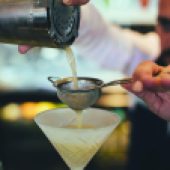From the French 75 immortalised by Humphrey Bogart in Casablanca to the Manhattan sipped by Marilyn Monroe in Some Like it Hot, not to mention the Vodka Gimlet favoured by Jack Nicholson in About Schmidt, cocktails are synonymous with a particular kind of cool. They have a rich history, and the word as we know it dates back to 1806 when an American newspaper defined a cocktail as a ‘stimulating liquor composed of any kind of sugar, water and bitters’. The golden age of the cocktail was in the 1920s, when the Jazz Age took hold, and was revived post-war in the 1950s.
Cocktails are undergoing another renaissance today, and an estimated 8.7 million Brits now enjoy them when going out to eat or drink. While the Mojito is our favourite, the cheeky Pornstar Martini and the tangy Aperol Spritz are closing in, and there are more exotic and delectable recipes emerging all the time, not least on the north coast of Cornwall. Coast spent an afternoon at Newquay’s Fistral Beach Hotel under the watchful eye of resident mixologist, Jesús Elias, who taught us how to make sumptuous, heart-warming cocktails as the sea raged outside.
4.30PM – IN HIGH SPIRITS
Jesús appears at the hotel’s Bay Bar, arms spread wide and with a huge grin. Originally from Seville, he learnt his cocktail-making skills in Spain but has since washed up on the shores of Cornwall where he can ply his mixologist trade while also finding time to catch some waves at one of the UK’s top surf spots. Laid out on a crisp white serviette in front of us is a gleaming silver Hawthorne Strainer, with its distinctive flat top and semi-circle of springs, a classic long bar spoon and a pestle. We are also given large and small cocktail shakers and a jigger spirit measure.
Jesús explains that a good cocktail has three key components – the base spirit, such as gin, vodka, whisky or rum; the modifier, such as egg white, cream, fruit juice or syrup to give flavour and smoothness; and a garnish, such as fruit or herbs. We are going to make three cocktails, each created to appeal to hotel guests during the chilly winter months. The first is the Sloe Autumn, inspired by a time when leaves start to fall, the sea temperature drops, and dark purple sloes are ripe for the picking.
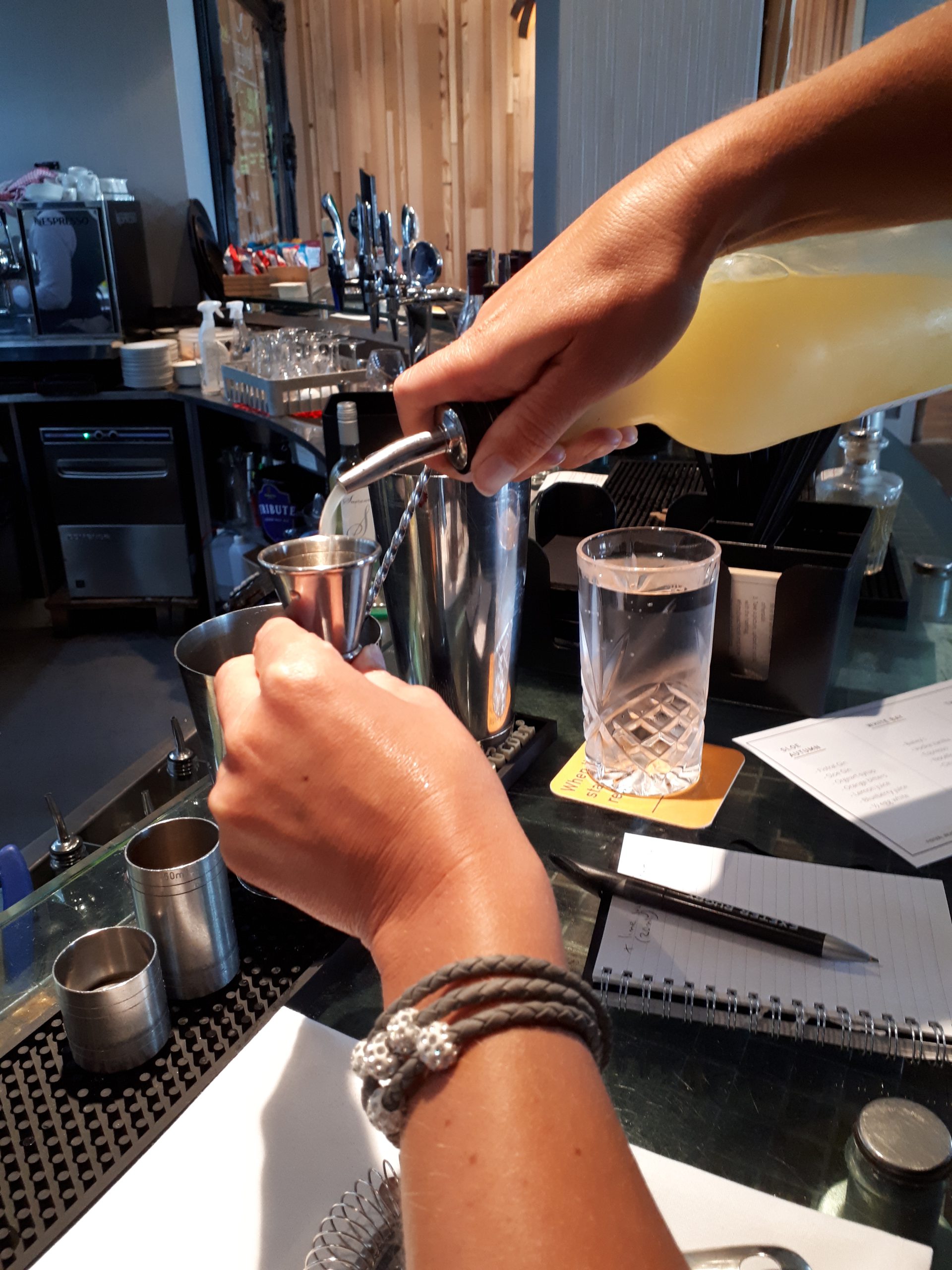
5PM – SLOW WORK
We start making the Sloe Autumn by crushing four blueberries in the small shaker using the pestle. We measure out some Fistral Gin, distilled in partnership with Devon-based artisan distiller, Still On The Move, and infused with angelica root, juniper berries, fennel, pink grapefruit, pink peppercorns, elderflower and orange peel. A heady orange aroma fills the air. Jesús measures his quantity and adds it to the shaker with one deft movement and a flourish. We are slightly more hesitant, ensuring we pour just the right amount into the jigger.
We add Plymouth Sloe Gin followed by a small amount of very sweet orgeat (almond) syrup, made with almonds, sugar and water. After a squeeze of lemon juice comes the tricky part – separating the egg white from the yolk. Jesús demonstrates his technique before nervously watching us do the same, the gloopy albumen dripping slowly into the existing concoction. Perhaps a snifter of gin would help to steady our hands?
We stir it and Jesús adds a scoop of ice cubes before we wedge the large shaker on to the small shaker at 45°, banging it tight with the heel of our hand to form a seal, and inverting it. Then it’s time for the showy bit – the flamboyant shaking of the mixture which is integral to a successful cocktail. Jesús says he has once known the drink to escape over his shoulder thanks to an ill fitting seal, but I promise not to tell anyone.
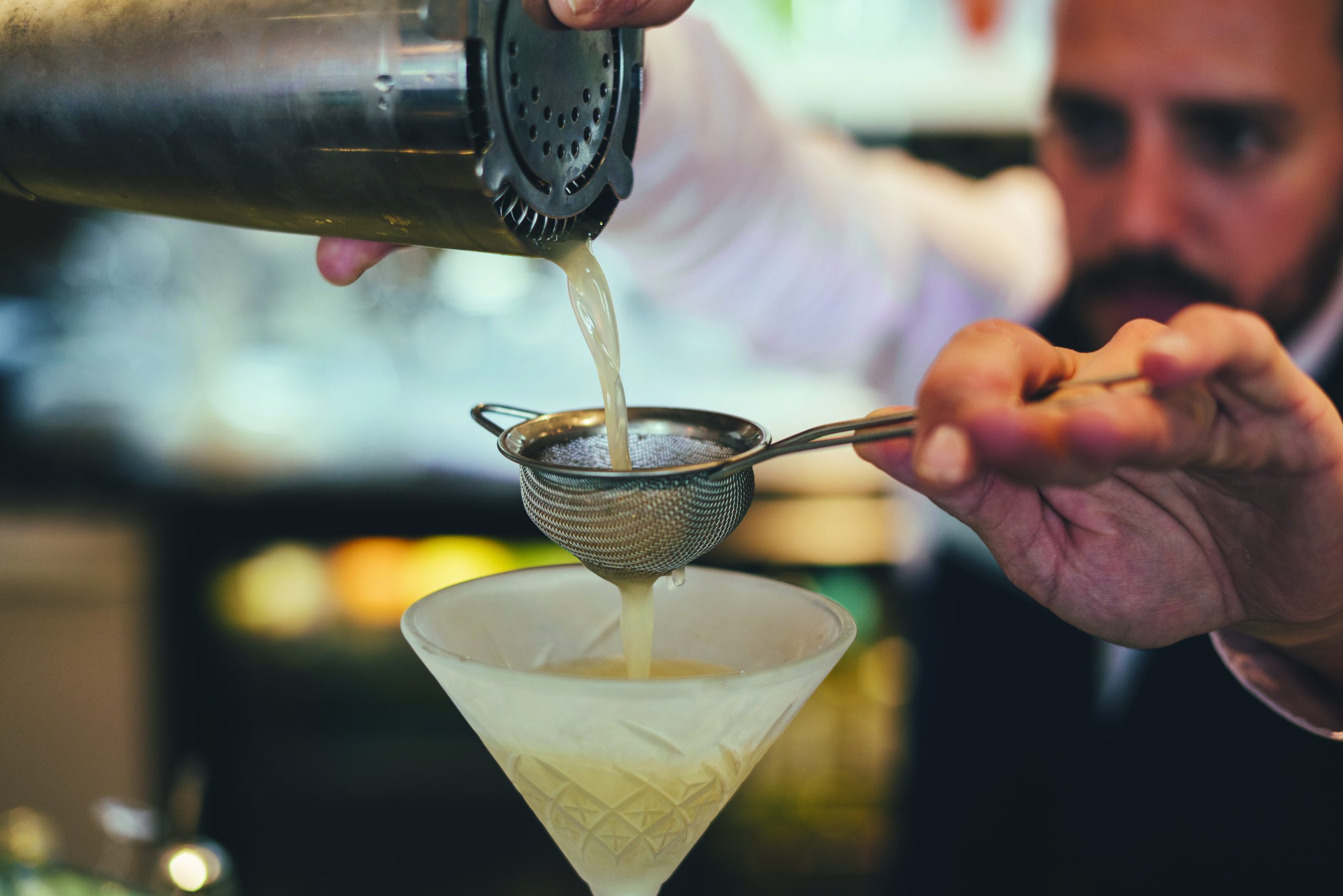
5.15PM – DO THE SHAKE
We shake our cocktails hard for fifteen seconds, starting tentatively in case the mixture leaks out, and finishing with gusto. It’s certainly a good way of toning the biceps. The two shakers come apart by smacking the top of the large shaker to break the seal. Jesús achieves this with one confident blow. We, however, take several attempts before the two shakers separate with a satisfying click. The group of curious onlookers are suitably impressed.
We pour our creations through the strainer into an elegant frozen Martini glass before garnishing them with three uniformly sized blueberries on a stick, curled expertly over the rim of the glass. The result is a punchy almond and sloe hit with subtle blueberry notes.
But we have to concede that, while ours are highly quaffable, Jesús’s creation has a slightly smoother texture with more of a citrus zing. He insists that it is down to using very precise measurements and – I suspect – to his more refined shaking action. His bar colleague, George, tries each cocktail and diplomatically says they are ‘all excellent’.

5.30PM – PURE MIXOLOGY
Next on the menu is the White Bay, which uses one of Jesús’ favourite spirits, Baileys. This cocktail also uses vanilla vodka, espresso and Nocello walnut liqueur, promising a warm, creamy, nutty caffeine boost. We begin by breaking a cinnamon stick into flaky small pieces to release the aroma, placing it into the small shaker. We then measure our Baileys, before adding a shot of hot espresso and some vanilla vodka. ‘Be confident with the bottle,’ urges Jesús. We watch as he brandishes the neck of the bottle between thumb and forefinger and the vodka cascades into the jigger with ease.
Nocello is an eye-watering 24% proof so only a small amount is required. We add a scoop of ice, thrust the large shaker onto the small shaker to form the all-important seal, flip it over and shake. We ‘double strain’ the mixture through two strainers (to ensure we don’t find ourselves crunching pieces of woody cinnamon later) and into a striking frozen old fashioned glass, adding oversized ice cubes which Jesús has made using hot water. He tells us that making ice with hot water rather than cold produces crystal clear ice cubes – another trick with which to wow our friends.
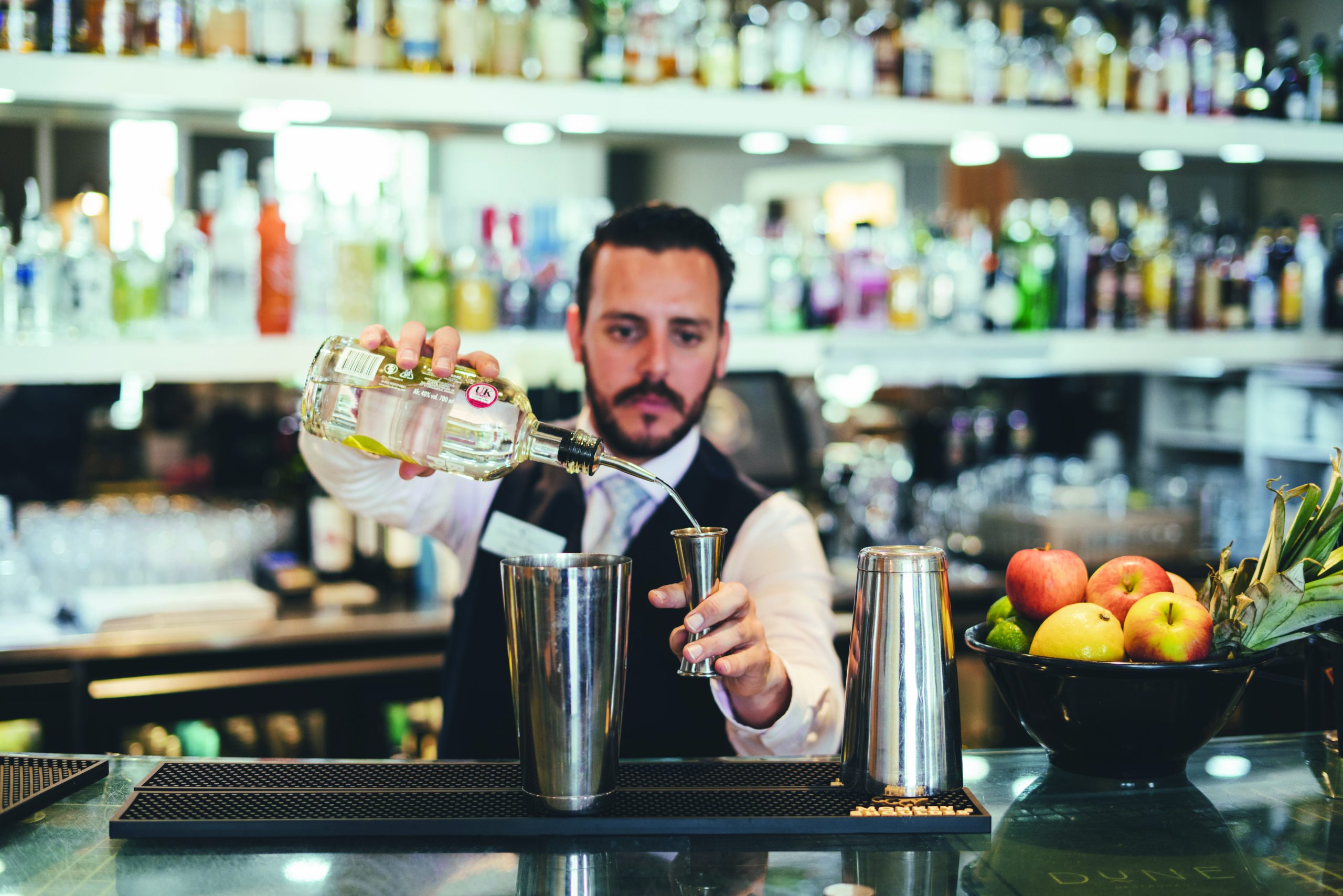
5.50PM – PRETTY EMBELLISHMENTS
Now for the finishing touches: we cover half the drink with a serviette and sprinkle cinnamon on the other half to give a striking half moon appearance, before garnishing with a delicately poised cinnamon stick. There is an audible gasp from the now sizeable audience who sip their decidedly dull looking beers nearby.
We enjoy our White Bays in the window, looking not unlike a couple of very smooth Don Drapers (well, the female version). While this cocktail delivers a toasty warmth, it is slightly too creamy for my liking. I manage a few mouthfuls before the judging, when George awards my friend the accolade of best cocktail (second to Jesús of course). He is right. Mine packs a little less punch and perhaps needed slightly more Nocello. Or Baileys. Or vanilla vodka. Next time…
6PM – FIZZY PERFECTION
Our last cocktail looks possibly the most spectacular in the photos, capturing the evocative deep red of Christmas topped with a fine layer of white snow. It also includes the indulgence of fizz – in this case, Cornwall’s own Camel Valley Brut Rosé – which feels decidedly naughty. We begin by emptying a tiny pot of wonderfully aromatic blackberry jam into the small shaker and adding Tanqueray 10 gin and some homemade sugar syrup. On top goes a liberal squeeze of lime juice. As we mix it up with the bar spoon, the liquid turns crimson as the jam blends with the other ingredients.
We add a small scoop of ice into the small shaker to keep the drink cool, not dilute it. We wedge the shakers and turn them upside down before shaking vigorously, attempting to replicate Jesús’ slick action. The resulting concoction is double strained into a Champagne flute, and we push the remnant mixture through the strainer to ensure none of the rich flavour is lost.
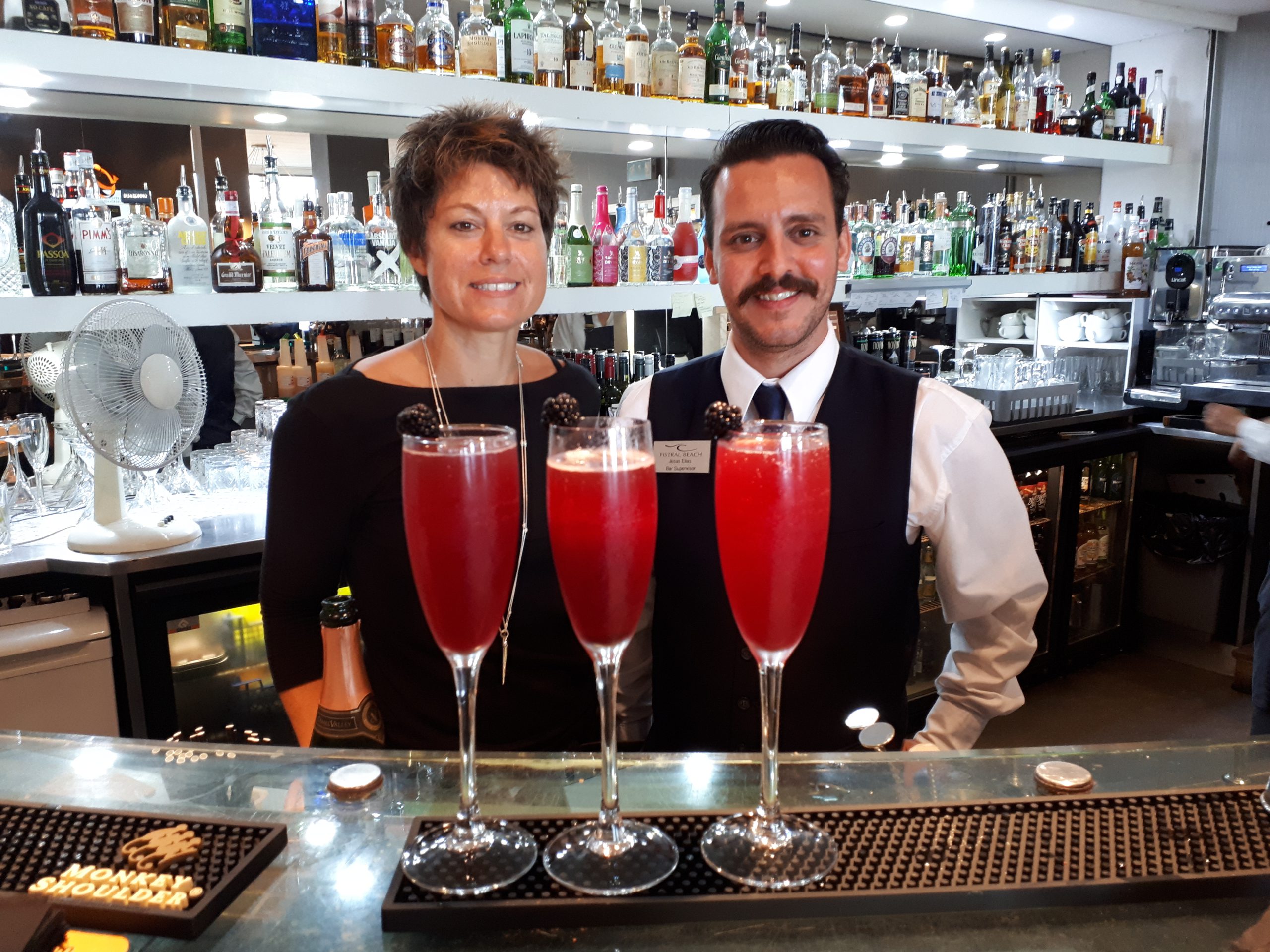
6.15PM – FINISHING TOUCHES
The final third of the glass is carefully topped up with the fizz, the bubbles settling to produce a fine white froth. We carefully add a blackberry to the rim of the glass and take our first sip. In addition to looking striking, The Winter Ruby really is the taste of Christmas, or indeed, of any wintertime celebration, embodying a luxurious fruity richness that lingers on the tongue.
Outside, large waves are still surging onto the shore as we sit down to enjoy our final creations, toasting Jesús, George and the magic of winter as other guests steal wistful glances at our creations. As we sip, we pick out the hardy surfers skimming over the icy swell beyond, feeling more than a little smug at our inner glow.
NEED to KNOW
BOOKING A CLASS
Aspiring mixologists can book a two-hour cocktail making class at Fistral Beach Hotel for £29pp. Participants can also make a night of it by dining in the hotel’s Dune Restaurant for £54pp. Book online here or call 01637 817305.
GETTING THERE
- By car: Newquay is only 15 minutes off the A30 via the A39 and the A392. Fistral Beach Hotel is on Esplanade Road overlooking Fistral Beach.
- By air: The hotel is only a 20-minute drive from Newquay Airport, which has up to three flights a day from London.
- By bus: Newquay bus station is in Newquay town centre, a 15-minute walk from the hotel.
- By rail: Newquay train station is close to Tolcarne Beach, a short walk through town to Fistral Beach. Newquay has its own branch line and there are often connecting trains from Par to Newquay.
WHERE TO STAY
There are plenty of options to suit every budget in bustling Newquay, but rooms at the adults-only Fistral Beach Hotel start at £89 for B&B in an ‘Economy’ room (Nov-Feb), to £313 for B&B in a ‘Suite’. Guests can also choose from sea view rooms and a private balcony in the ‘Best’ rooms. Prices include access to the spa, which has an indoor swimming pool, hot tub, steam room, sauna and gym. Breakfast and dinner is served in the Dune restaurant, with expansive views across Fistral Beach. Try the mackerel fillet to start and don’t forget to sample the Bloody Shame for breakfast – a Bloody Mary without the vodka. It’ll clear the post-cocktail fog (01637 817305, fistralbeachhotel.co.uk)
If you’re searching for more staycation hotspots for your Cornish break, try these top Cornwall hotels.
ASK THE PRO
Jesús Elias started mixology as a hobby but fell in love with the process straight away and decided to pursue it as a career. He spent five years in his native Spain teaching himself the art of making cocktails, learning through experimentation, research and tasting. The creativity involved in making cocktails particularly attracts him to being a mixologist. ‘It’s a chance to be adventurous with flavours, colours and presentation.’
Cocktail stats – Source CGA, 2018 – http://www.cga.co.uk/2018/04/26/cocktail-sales-continue-to-soar-as-new-trends-emerge/]

